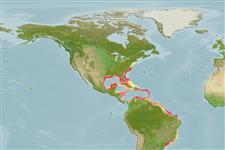Environment: milieu / climate zone / depth range / distribution range
بوم شناسي
دريايي; لب شور وابسته به آب سنگ; اقیانوس رو (Ref. 51243); تغييرات عمق 30 - 160 m (Ref. 89707). Subtropical; 40°N - 27°S, 98°W - 38°W (Ref. 5222)
Western Atlantic: North Carolina, USA (with juveniles occurring as far north as Massachusetts) to the Yucatan Peninsula, Mexico. Rare in Bermuda; one record in Cuba; also reported from eastern Brazil.
Length at first maturity / Size / Weight / سن
Maturity: Lm 63.1, range 51 - ? cm
Max length : 145 cm TL جنس نر / بدون خواص جنسي; (Ref. 40637); common length : 50.0 cm TL جنس نر / بدون خواص جنسي; (Ref. 3708); بيشينه وزن گزارش شده: 36.5 kg (Ref. 40637); بيشينه سن گزارش شده: 31 سال ها (Ref. 118445)
خارهاي باله پشتي (کل): 11; شعاع نرم باله پشتي (کل): 16-18; خارهاي باله مخرجي 3; شعاع نرم باله مخرجي: 10 - 12. Distinguished by the following characteristics: adult females and juveniles are generally brownish grey with dark vermiculations; camouflage phase has 5 dark brown saddles separated by short white bars below the dorsal fin; large males sometimes display a "black-belly" and "black-back" phase; black-belly phase is mostly pale grey, with faint dark reticulations below soft dorsal fin, belly and ventral part of the body above anal fin black, as are margin of the soft dorsal fin, central rear part of caudal fin and rear margins of pectoral and pelvic fins; depth of body contained 3.0-3.5 times in SL; head length 2.5-2.7 times in SL; convex interorbital area; angle of preopercle produced into a rounded lobe bearing enlarged serrae; posterior nostrils of adults much larger than anterior ones; smooth lateral body scales, except those covering pectoral fin (Ref. 89707).
Juveniles occur in estuaries and seagrass beds; adults are usually found offshore on rocky bottom (rarely to 152 m), occasionally inshore on rocky or grassy bottom. It is the most common grouper on rocky ledges in the eastern Gulf of Mexico. Adults are either solitary or in groups of 5 to 50 individuals; feed mainly on fishes, some crabs, shrimps, and cephalopods. Juveniles (less than 20 cm) feed mainly on crustaceans that live in shallow grass beds.
Indeterminate, multiple spawner (Ref. 86690).
Heemstra, P.C. and J.E. Randall, 1993. FAO Species Catalogue. Vol. 16. Groupers of the world (family Serranidae, subfamily Epinephelinae). An annotated and illustrated catalogue of the grouper, rockcod, hind, coral grouper and lyretail species known to date. Rome: FAO. FAO Fish. Synop. 125(16):382 p. (Ref. 5222)
وضعيت در فهرست قرمز IUCN (Ref. 130435)
خطر برای انسان ها
Harmless
استفاده انسانی
ماهي گيري – شيلات: با ارزش تجاري بالا; ماهي ها ي سرگرم كننده: بله
اطلاعات بيشتر
مراجعآبزي پرورينمايه آبزي پرورينژادهاژنتيكElectrophoresesوارثبيماري هافرآوریNutrientsMass conversion
ابزارها
گزارش های ويژه
بارگيری XML
منابع اينترنتي
Estimates based on models
Preferred temperature (Ref.
123201): 18.3 - 27.1, mean 23.8 °C (based on 123 cells).
Phylogenetic diversity index (Ref.
82804): PD
50 = 0.5000 [Uniqueness, from 0.5 = low to 2.0 = high].
Bayesian length-weight: a=0.00955 (0.00767 - 0.01189), b=3.04 (3.01 - 3.07), in cm total length, based on LWR estimates for this species (Ref.
93245).
Trophic level (Ref.
69278): 3.7 ±0.4 se; based on diet studies.
جهندگی (Ref.
120179): متوسط, كمينه زمان لازم براي دو برابر شدن جمعيت 4/1 – 4/4 سال (K=0.12-0.16; tm=3-8; tmax=16; Fec>10,000).
Prior r = 0.51, 95% CL = 0.34 - 0.77, Based on 1 stock assessment.
Fishing Vulnerability (Ref.
59153): High vulnerability (62 of 100).
Climate Vulnerability (Ref.
125649): High to very high vulnerability (73 of 100).
Nutrients (Ref.
124155): Calcium = 11.5 [6.4, 24.2] mg/100g; Iron = 0.464 [0.235, 0.829] mg/100g; Protein = 19.5 [17.6, 21.1] %; Omega3 = 0.214 [0.122, 0.378] g/100g; Selenium = 24.6 [12.6, 49.8] μg/100g; VitaminA = 38.1 [11.4, 150.0] μg/100g; Zinc = 0.57 [0.38, 0.89] mg/100g (wet weight);
